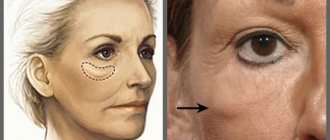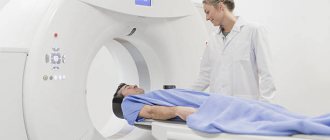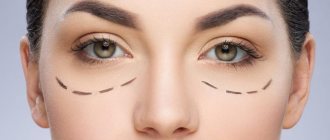- Rehabilitation after edema
- Guasha massage on the face
- Microcurrent therapy
Morning swelling sometimes changes the face beyond recognition. Almost everyone is familiar with the problem of edema, but few know why it appears, how swelling on the face can be prevented and what methods of eliminating edema are offered by cosmetology.
Factors that cause swelling on the face
So, swelling on the face is a consequence of weak lymph outflow, which in turn leads to stagnation of intercellular fluid. Similar disturbances in the outflow of lymph occur if the drinking regime is disrupted, for example, when an insufficient amount of water is systematically consumed throughout the day. Other factors that cause swelling include:
- chronic heart and kidney diseases;
- allergy;
- alcohol consumption;
- pregnancy.
If for unknown reasons swelling appears every day, you should consult a doctor. It will help rule out serious diseases that may be causing swelling. If facial puffiness in the morning is not associated with health problems, then you should reconsider your usual lifestyle. The causes of edema can also be:
- stress – strengthens the temporomandibular clamp and interferes with the outflow of lymph;
- Excessive eating before bed – the body does not have time to process food and remove toxins;
- prolonged fasting, unbalanced diets, unhealthy diet;
- a sedentary lifestyle, long work at the computer - also lead to disruption of lymphatic movement;
- using fatty creams before bedtime;
- An uncomfortable pillow, the habit of sleeping face down - blood circulation in the head and neck is impaired.
If there is edema, it is necessary to maintain a drinking regime, which means that you need to drink at least 1.5 liters of water per day. However, after eight in the evening you can drink a maximum of 1 sip of water every half hour. Before going to bed, it is also undesirable to eat salty and spicy foods, as they retain fluid in the body.
To avoid swelling, you need to adhere to a healthy lifestyle, walk in the fresh air more often and maintain physical activity. It is better to finish all cosmetic procedures 3 hours before bedtime.
Types of edema
Depends on origin:
- Lymphatic - those types of edema that are caused by causes and changes associated with the lymphatic system are considered as such. Among them are primary (there are congenital malformations of the lymphatic system, usually affecting the limbs), or secondary (there are acquired damage). The latter may be the result of operations to remove tumors in the lymphatic system, or in cases of burns, strokes or infections that cause vessel destruction.
- Dynamic - the lymphatic system does not show any changes, but excess fluid is felt. These include swelling of the veins caused by blood clots or problems with the blood vessels caused by strokes, inflammation, and medications. In women, the cause is varicose veins and exposure to hormones during pregnancy and the postpartum period.
The main factors are changes in the biochemical composition of tissue fluid and blood plasma. Disturbances also occur against the background of hormonal changes and increased capillary permeability.
Cosmetic procedures for the treatment of facial swelling
If it was not possible to establish tissue drainage in time, then cosmetic procedures with a lymphatic drainage effect are an effective additional measure to combat swelling, such as:
- lymphatic drainage massage - can be hardware or manual, improves blood circulation, activates the movement of lymph, and also helps get rid of wrinkles and gives the skin elasticity;
- biorevitalization, SMAS-lifting, RF-lifting - procedures aimed at restoring water balance, activating blood flow, stimulating collagen production and accelerating lymph movement;
- microcurrent therapy - stimulates the dermis, activates capillary blood circulation, eliminates pastiness and pronounced wrinkles.
To achieve maximum effect, cosmetic procedures must be carried out in a course. The number of sessions and their frequency are determined by the cosmetologist at a preliminary consultation.
Diagnostic stages
Consultation and examination by a therapist. After a detailed conversation and medical examination, the patient can be referred for consultation to other specialists depending on the etiology of the disease: cardiologist, allergist, endocrinologist, nephrologist, urologist, etc.
Laboratory research. First of all, the following are carried out:
- general (with leukocyte formula) and biochemical blood tests;
- general urine analysis.
- Instrumental studies:
- ECG;
- echocardiography;
- Ultrasound of blood vessels of the lower extremities;
- X-ray of the chest organs.
Next, the doctor prescribes a set of studies on an individual basis in each individual case.
To effectively eliminate swelling, you need to know exactly what disease is causing it. Edema is not an independent disease, but a symptom. Diagnostics using modern equipment will allow us to determine the cause of the pathology. The information obtained allows the doctor to choose the most effective treatment. Don't put off taking care of your health until later. Schedule a consultation with your doctor today to stay energized for years to come.
sign up for a consultation
Why us
Advantages of visiting our medical center:
- Doctors. We welcome specialists of the highest qualification category, holders of academic degrees, with extensive experience in leading Russian clinics.
- Individual approach. The doctor will develop an individual treatment plan for each patient in accordance with the cause of development and clinical picture of the disease.
- Complexity. Effective treatment of edema and the diseases that cause them is possible thanks to the close cooperation of our clinic’s specialists - therapist, cardiologist, allergist, endocrinologist, urologist, etc.
- Expert equipment. All studies are carried out using modern equipment and are highly accurate.
- Comfort. All consultations, studies and treatment are carried out within our hospital, which allows our patients to save money.
You can see prices for services in the price list or check by calling the phone number listed on the website.
Disorders associated with swelling of the eyelids
By morning, not our entire face may swell, but only the area around the eyes. Bags appear on the lower eyelids, the upper ones float, droop and turn your beautiful big eyes into “slits”. You look sleepy and sick.
Such selective facial swelling is not uncommon. The area around the eyes is the best indicator of lymphatic problems. This is where excess liquid tends first.
Why? Because this is the most vulnerable area. The skin of our eyelids is the thinnest, 6 times thinner than on the cheeks. In addition, there is a mass of lymphatic and blood vessels in/under it. The lymph happily fills the “pockets” formed here, and your usually open gaze can no longer be seen in the shapelessness of the puffy “glasses”.
Allergic reaction as a cause of facial swelling
Food products, medicines, so-called common allergens (plant pollen, insect chitin), industrial pollution, genetic predisposition, certain pathological conditions - all these are factors that can provoke an allergic reaction and cause swelling of the face.
You apply the cream to your face, and almost immediately you begin to feel itchy skin, after 2 minutes red spots appear, and after a few minutes your face begins to swell. This is urticaria - a type of allergy that affects one in five people.
Another variant of an allergic reaction in which swelling of the face is possible is Quincke's edema. Unlike the previous one, this form of allergy is not accompanied by itching and redness of the skin; swelling of the subcutaneous fat occurs. The swelling of the face that occurs against the background of allergies spreads to the tongue and pharynx, which is accompanied by an attack of suffocation. In severe cases, anaphylaxis develops. In addition to facial swelling, this pathology causes:
- “Lump in the throat”, burning and tightness in the chest;
- Transfer of the rash to other parts of the body;
- Attack of suffocation.
This situation requires urgent medical attention.
How to get rid of swelling
Woke up with a swollen and bruised face, but no time, need to run errands?
We offer you several express methods to combat a sleepy face:
- Contrast wash.
Wash your face alternately with cold and warm water. This way you will activate microcirculation, reduce swelling and improve skin color. - Massage.
Lymphatic drainage techniques are the best help for your face when you need to quickly “dry” it. We force the lymph to move with the help of:- General lymphatic drainage:
look at what a simple and fun exercise there is for this, called “Cockroach”: - Self-massage of face and neck.
You can quickly remove swelling from the face by working on the chin, lower jaw, ears, and periorbital area. The main lymphatic channels are located here, and there are also lymph nodes near the ears and under the lower jaw. - Vacuum cans.
Massage with vacuum cans provides an excellent lymphatic drainage effect.Apply squalane or light oil to your skin and do as Annette does:
You can buy glass jars for the Beauty365 face at www.beauty365.ru.
- Masks and compresses according to folk recipes.
If you have 15-20 minutes left, you can apply something homemade decongestant to your face during this time:- Compress with tea.
Cool the brewed tea bags in the refrigerator (both black and green tea will do) and apply to problem areas.
Compress with chamomile infusion.
Soak gauze or a piece of cloth in the infusion and apply it to your face. - Compress with tea.
- Parsley mask.
1 tsp. parsley, ground to a paste + 1 tbsp. sour cream. - Potato mask.
Grate half a potato tuber + 1 tsp. milk + 1 tsp. flour
It's even better to massage not only your face. To drive fluid from it through the lymphatic tract and nodes, it is also necessary to work on the neck and areas above the collarbones and in the armpit area (there are “flocks” of lymph nodes there).
All of these options for masks and compresses can be applied to any area of the face, even under the eyes.
Treatment
Pre-hospital assistance
To eliminate the physiological causes of facial swelling, it is necessary to adjust the diet, normalize the daily routine, avoid stress, and select suitable cosmetic preparations. Mild allergic edema in the absence of signs of breathing difficulties and the presence of a previously established diagnosis can be eliminated with the help of antiallergic drugs.
In other cases, self-medication is not recommended. It should be borne in mind that self-administration of diuretics can lead to the development of serious side effects and disorders of the body.
Specialized treatment
Many patients require adjustments to their diet and eating regimen. The tactics of conservative treatment are determined by the etiology of the disease or condition that provoked facial swelling:
- Hormonal fluctuations in women
. Hormonal medications and sedatives are used. - Hypothyroidism
. Replacement therapy with levothyroxine is carried out. If there is a lack of iodine, iodine-containing medications are prescribed. - Allergic reactions
. Antihistamines and glucocorticosteroids are effective. In severe cases, resuscitation measures are necessary. - Kidney diseases
. For glomerulonephritis, antibacterial agents and drugs to correct immunity are indicated. For systemic diseases, treatment of the underlying pathology is required. In all cases, medications with symptomatic effects are used. - Diseases of the heart and blood vessels
. Cardiac glycosides, nitrates, vasodilators, B-blockers, anticoagulants, and drugs to improve cardiac muscle metabolism may be recommended. - Intoxication
. If edema is associated with smoking and drinking alcohol, the patient is advised to give up the bad habit and is given medicinal and non-medicinal treatment to eliminate the addiction. - Poisoning
. In some cases, gastric lavage is possible. Carry out detoxification measures.
For hypovitaminosis, vitamin preparations are prescribed, for acute infections, symptomatic therapy is carried out, for ENT diseases, antibiotics and symptomatic drugs are used, and sinus punctures are performed. Surgical treatment is rarely required. In case of heart defects, surgical correction is performed. Tonsillitis and sinusitis can be considered as indications for tonsillectomy, maxillary sinusotomy, and frontotomy.
Allergies and sensitivity to products
Sensitivity, or food intolerance, is a symptomatic reaction without the participation of the immune system. This is how it differs from allergic. Sensitivity is more common than allergies.
The effect of individual reactions to foods has been noted in a number of diseases and symptoms, including irritable bowel syndrome, weight gain, chronic headaches, skin conditions, autoimmune diseases and even depression. Swelling can also be a symptom of food sensitivity.
While the most common allergens are eggs, milk, nuts, wheat, soy, fish and shellfish, sensitivity can occur to unexpected foods.
For example, among arthritis sufferers, sensitivity to citrus fruits, pork, corn, oatmeal, coffee, cheeses, tomatoes, sugar, chocolate, wheat was found, and among migraine sufferers, food additives, preservatives, tea, potatoes and salt were added to the list.
| To find out what food causes swelling, you need to give up potentially problematic foods for several weeks one at a time. If the symptoms weaken or disappear, you have found a product that should be excluded from the diet. |
Another approach is to switch to a diet consisting of a minimum amount of foods for the same period of time, then gradually return them, observing the changes.
Potentially problematic foods: allergenic foods, fruits, alcohol, gluten-containing foods, milk and dairy products, food chemicals, spices and sugar.
Can dairy products, fruit, stress or too intense exercise cause swelling? Yes they can. But you shouldn’t limit yourself in food or physical activity - first, find out what exactly your reason is.
Author: Elena Degtyar, PhD, nutrition psychology coach and nutritionist
LITERATURE:
1. Maughan, R. J. “Impact of mild dehydration on wellness and on exercise performance.” European journal of clinical nutrition 57.S2 (2003): S19. 2. Xie, Lulu, et al. “Sleep drives metabolite clearance from the adult brain.” science 342.6156 (2013): 373-377. 3. Kannan, Arun, et al. "Renal sympathetic nervous system and the effects of denervation on renal arteries." World journal of cardiology 6.8 (2014): 814. 4. Gallen, Ian W., et al. "On the mechanism of the effects of potassium restriction on blood pressure and renal sodium retention". American journal of kidney diseases 31.1 (1998): 19-27. 5. Kreydiyyeh, Sawsan Ibrahim, and Julnar Usta. "Diuretic effect and mechanism of action of parsley". Journal of ethnopharmacology 79.3 (2002): 353-357. 6. Horita, Shoko, et al. "Insulin resistance, obesity, hypertension, and renal sodium transport." International journal of hypertension 2011 (2011). 7. Light, Kathleen C., et al. "Psychological stress induces sodium and fluid retention in men at high risk for hypertension." Science 220.4595 (1983): 429-431. 8. Espiner, Eric A. “The effects of stress on salt and water balance.” Best Practice & Research Clinical Endocrinology & Metabolism 1.2 (1987): 375-390. 9. Riebl, Shaun K., and Brenda M. Davy. “The hydration equation: Update on water balance and cognitive performance.” ACSM's health & fitness journal 17.6 (2013): 21. 10. Hong, Seung Min, et al. "Changes in Body Water Caused by Sleep Deprivation in Taeeum and Soyang Types in Sasang Medicine: Prospective Intervention Study." Evidence-Based Complementary and Alternative Medicine 2022 (2017). 11. Gerth van Wijk R, van Cauwenberge PB, Johansson SG. Revised terminology for allergies and related conditions. Ned Tijdschr Tandheelkd. 2003, 110: 328-331. 12. Gaby AR. The Role of Hidden Food Allergy/Intolerance in Chronic Disease. Alternative Medicine Review. 1998, 3: 90-100. 13. Tarasova, I. V. “Food intolerance, true food allergy and food pseudo-allergic reactions: presentation and diagnostic methods.” Allergology and Immunology in Pediatrics 3 (2008): 24-28.
The concept of pastiness
Pastiness of the face appears as a result of impaired distribution of fluid in the face
The name of this condition comes from the Latin word “pasta”, since the signs of the pathology make the face look like dough. Everyone knows that the human body consists of a large amount of water, which is part of the cells, helping to keep the skin in a firm, elastic state. As a result of a violation of the distribution of fluid in the body, a change in blood circulation occurs, leading to improper outflow of lymph and intercellular fluid, resulting in pastiness, swelling and looseness of facial tissues.
Some of the provocateurs of chronic fluid outflow disorders are:
- thinning of the walls of capillaries and blood vessels;
- increased pressure in the bloodstream, for example with an excess of sodium ions (salts).
The development of the defect is facilitated by disruptions of the immune, nervous, endocrine, and respiratory systems, as well as diseases of the liver, kidneys, heart, blood vessels, and diabetes.
The pastiness of the face makes it look old. Pathology can occur at any age. Its localization directly depends on the anatomical features of the structure of the face, its position during sleep and the presence of diseases of the internal organs.









